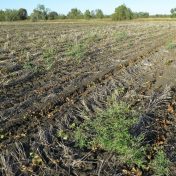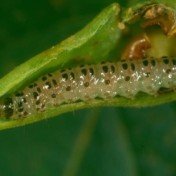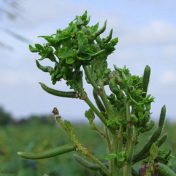Halo blight, caused by a bacterial pathogen (Pseudomonas savastanoi pv. phaseolicola) is one of the major diseases of beans world-wide, particularly in temperate regions. In mungbean, symptoms on leaves start as small, water-soaked lesions that are surrounded by a yellow-green halo (Figs 1 and 2). Symptoms may be visible at the 1st or 2nd trifoliate leaf stage and are often… Read more »
Key points: There was a resurgence in tobacco streak virus (TSV) disease in mungbeans in early 2020 TSV is restricted to central QLD and closely related to the distribution of parthenium weed Growers are encouraged to avoid areas of dense parthenium to reduce risk In autumn of 2020, tobacco streak virus (TSV) was found to be common in all mungbean… Read more »
Several growers and agronomists across southern Queensland have reported extensive damage to their mungbean crops due to Fusarium wilt this season. Large areas of affected paddocks have plants that are wilted or dead, resulting in significant yield losses. The results of DAF annual disease surveys over the last five years have found that the disease is most common in crops… Read more »
Leafhoppers (also known as jassids) and seedling thrips are extremely abundant in Central Queensland this summer. The vegetable leafhoppers (Austroascra viridigrisea) are very much an ‘in your eye’ pest, with swarms of the small (3mm) bright green critters flying up when disturbed in-crop. In contrast, the cotton seedling or cereal thrips (Thrips tabaci) are hiding out of sight, down in… Read more »
Observations from recent Pulse Check field days in CQ Bean podborer (Maruca vitrata) and beet webworm (Spoladea recurvalis) are on the move in Central Queensland (CQ) mungbean crops. While both species may also be active in other mungbean regions, bean podborer is most likely to occur in coastal (e.g. the Burdekin) and subcoastal (Biloela, Kingaroy) regions. Bean podborer is a… Read more »
Phytoplama has been reported in second flower flushes in mungbeans, and also in harvested mungbean regrowth! So far the overall incidence of phytoplasma has been lower than this time last year, but growers and consultants are urged to keep monitoring their crops for the first symptoms of this disease, and to report any outbreaks. Many January-planted mungbean crops are at… Read more »
Last summer saw unprecedented levels of phytoplasma in summer pulses/legumes (including chickpeas, mungbeans and pigeon peas) in all cropping regions in eastern and northern Australia from the Ord Irrigation area (WA), Burdekin/Atherton Tablelands (NQ), to central NSW. The most likely insect vector is the brown leafhopper Orosius orientalis, which has been detected in recent (2017) spring crops. While plantings of… Read more »
Although typically only in low numbers in the Northern Grains region, Rutherglen bugs (RGB; Nysius vinitor) were observed at very high densities (e.g. 50 RGB per pod) in many crops last year. A glasshouse study was conducted to determine at what plant stage mungbeans were most susceptible to RGB damage, in terms of both yield and seed quality. To do… Read more »
A devastating disease was observed in several paddocks of soybean crops in the Branchview area of the Darling Downs in late autumn 2016. Almost 100 percent of plants were affected in some paddocks. The affected plants produced no, or very few filled pods and instead had a proliferation of tiny immature pods as shown in Photos 1 and 2. The plants… Read more »
Bean podborer (Maruca vitrata) have been observed in large numbers (>20/m2) in flowering/podding mungbeans planted from January onwards in the Burnett region. They are likely to be present in other coastal/subcoastal regions such as the Burdekin, Callide Valley and the Wide Bay/Burnett (particularly in late-planted crops), and to a lesser extent in the eastern Darling Downs, and Emerald in Central… Read more »








